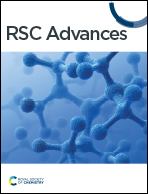Influences of Ru and ZrO2 interaction on the hydroesterification of styrene†
Abstract
Interfacial Lewis acid–base pairs are commonly found in ZrO2-supported metal catalysts due to the facile generation of oxygen vacancies of ZrO2. These pairs have been reported to play a crucial role in olefin hydroesterification, especially in the absence of acid promoters and ligands. In this study, a series of ZrO2-supported Ru catalysts with ruthenium(III) chloride and ruthenium(III) acetylacetonate as precursors were prepared for the styrene hydroesterification. The catalysts were thoroughly characterized by TPR, TEM, EPR, XPS, and FTIR. The Ru precursors significantly influenced the size and electronic properties of Ru clusters, albeit having minimal impact on oxygen vacancies. Mechanistic studies of styrene hydroesterification over ZrO2-supported Ru catalysts revealed that the carbon monoxide insertion followed the hydrogen transfer step to activated styrene. Higher activity is exhibited over ZrO2-supported Ru catalysts prepared with ruthenium(III) chloride as a precursor, attributed to the lower adsorption strength of CO over Ru clusters, as evidenced by FTIR and DFT calculations.



 Please wait while we load your content...
Please wait while we load your content...